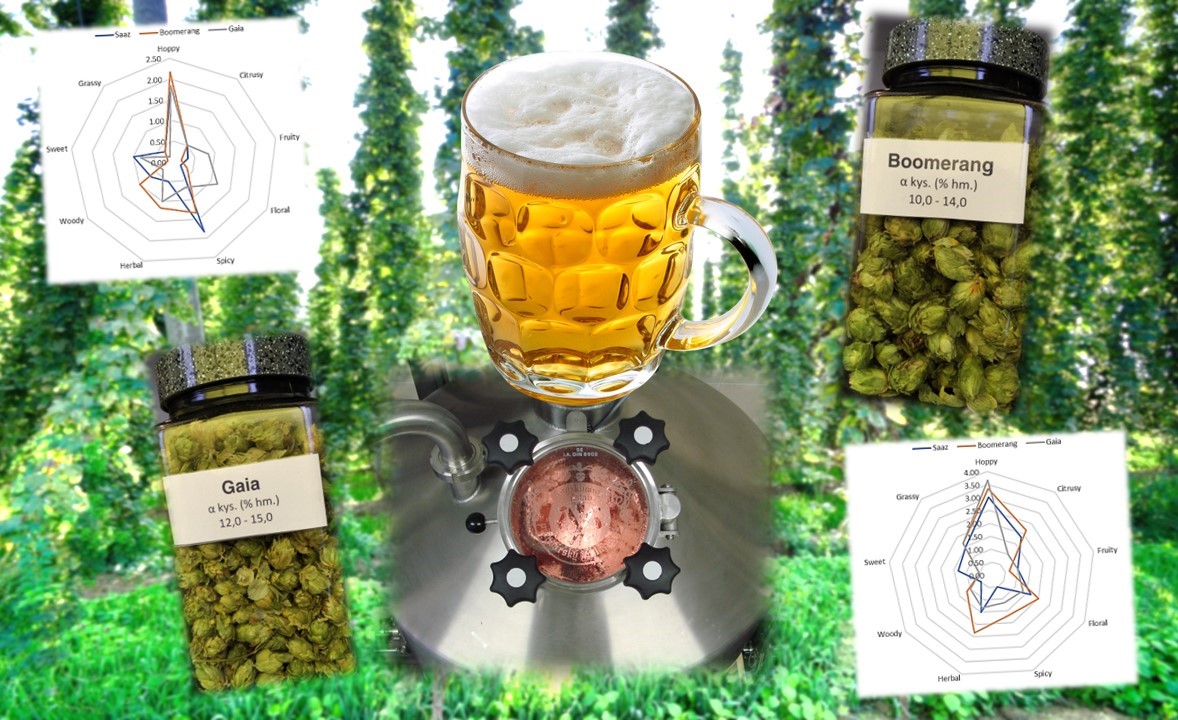Chemical and sensory profile of lager beers hopped with new Czech bitter varieties Boomerang and Gaia
DOI:
https://doi.org/10.18832/kp2024.70.943Keywords:
hop varieties, Boomerang, Gaia, dry hopping, sensory profile of beer, hop volatilesAbstract
Characterising the sensory profiles of beers made from new hop varieties is of considerable importance for their application in brewing. New Czech bitter varieties Boomerang and Gaia were tested in three-year pilot brews (200 l) of 12% single-hopped pale lager, produced in kettle and kettle+dry-hopped variants. The hop-derived aroma and bitterness profile of the beers was evaluated using a comprehensive descriptive method. Hop-related volatiles in beer were determined by GC/MS-MS method. Both of these bitter varieties showed a pleasant bitterness profile even in dry-hopped beers. The overall impression of the beers from the varieties tested was favourable, at the level of the control beer (Saaz). The profile of hop derived volatiles and aroma in beers from Gaia and Boomerang varieties were different. The results show the potential of Boomerang for both single kettle-hopped beers and dry-hopped lagers due to its interesting aroma profile (spicy, herbal, floral). The Gaia variety can be used in a similar way, with a preference for dry hopping to give a well-balanced hop-derived aroma profile. Both varieties have shown considerable potential for the production of new beer brands, and their drought tolerance may also help their widespread cultivation.
References
Algazzali, V., Shellhammer, T. (2016). Bitterness Intensity of oxidized hop acids: Humulinones and Hulupones. Journal of the American Society of Brewing Chemists, 74(1), 36–43. https://doi.org/10.1094/ASBCJ-2016-1130-01
Almaguer, C., Schonberger, C., Gastl, M., Arendt, E.K., Becker, T. (2014). Humulus lupulus - a story that begs to be told. A review. Journal of The Institute of Brewing, 120(4), 289–314. https://doi.org/10.1002/jib.160
Bandelt Riess, P.M., Engstle, J., Forst, P. (2020). Characterisation of hop particle separation for efficient dry hopping. Brauwelt International, 38(1), 15–20.
Basařová, G., Šavel, J., Basař, P., Lejsek, T. (2017). The comprehensive guide to brewing, Fachverlag Hans Carl, Nürenberg, p. 876.
Biendl, M., Engelhard, B., Forster, A., Gahr, A., Lutz, A., Mitter, W., Schmidt, R., Schonberger, C. (2014) Hops: Their Cultivation, Composition and Usage. Fachverlag Hans Carl: Nuremberg, Germany. ISBN-10: 3418008232, ISBN-13: 978-3418008233
CISTA [online]. National List Database. https://eagri.cz/public/app/sok/odrudyNouRL.do.[Accessed September 20, 2024].
Cocuzza, S., Zarnkow, M., Stallforth, A., Peifer, F., Jacob, F. (2019). The impact of dry-hopping on selected physical and chemical attributes of beer. BrewingScience, 72(5/6), 118–124.
Dietz, C., Cook, D., Huismann, M., Wilson, C., Ford, R. (2020). The multisensory perception of hop essential oil: a review. Journal of The Institute of Brewing, 126(3), 320–342. https://doi.org/10.1002/jib.612
Dietz, C., Cook, D., Wilson, C., Oliveira, P., Ford, R. (2021). Exploring the multisensory perception of terpene alcohol and sesquiterpene rich hop extracts in lager style beer. Food Research International, 148, 110598. https://doi.org/10.1016/j.foodres.2021.110598
Dresel, M., Praet, T., Van Opstaele, F., Van Holle, A., Naudts, D., De Keukeleire, D., De Cooman, L., Aerts, G. (2015). Comparison of the analytical profiles of volatiles in single-hopped worts and beers as a function of the hop variety. Brewing Science, 68(1/2), 8–28.
Dresel, M., Vogt, C., Dunkel, A., Hofmann, T. (2016): The Bitter Chemodiversity of Hops (Humulus lupulus L.). Journal of Agricultural and Food Chemistry, 64(41), 7789−7799. https://doi.org/10.1021/acs.jafc.6b03933
Dušek, M., Olšovská, J., Krofta, K., Jurková, M., Mikyška, A. (2014). Qualitative determination of β acids and their transformation products in beer and hop using HR/AM-LC-MS/MS. Journal of Agricultural and Food Chemistry, 62(31), 7690−7697. https://doi.org/10.1021/jf501852r
EBC-Analytica [online]. European Brewery Convention. https://brewup.eu/ebc-analytica/search [Accessed March 26, 2024].
European Committee of the Regions (2008). Other acts Commission Publication of an application pursuant to Article 6(2) of Council Regulation (EC) No 510/2006 on the protection of geographical indications and designations of origin for agricultural products and foodstuffs. Official Journal of the European Union. C16, 14–22.
Forster, A., Gahr, A. (2013). On the fate of certain hop substances during dry hopping. Brewing Science, 66(7/8), 93–103.
Forster, A., Gahr, A. (2014). A Comparison on the Analytical and Brewing Characteristics of Cascade and Comet Hop Varieties as Grown in Yakima (USA) and Hallertau (Germany). Brewing Science, 67, 137–148.
Fritsch, H.T., Schieberle, P. (2003). Changes in key aroma compounds during boiling of unhopped and hopped wort. Proceedings of the 29th Congress of European Brewery Convention, Dublin, 2003, Fachverlag Hans Carl: Nürnberg, Germany, CD-ROM.
Goiris, K., Jaskula-Goiris, B., Syryn, E., Van Opstaele, F., De Rouck, G., Aerts, G., De Cooman, L. (2014). The Flavoring Potential of Hop Polyphenols in Beer. Journal of the American Society of Brewing Chemists, 72(2), 135–142. http://dx.doi.org/10.1094/ASBCJ-2014-0327-01
Hahn, C.D., Lafontaine, S.R., Pereira, C.B., Shellhammer, T.H. (2018). Evaluation of Nonvolatile Chemistry Affecting Sensory Bitterness Intensity of Highly Hopped Beers. Journal of Agricultural and Food Chemistry, 66, 3505–3513. https://doi.org/10.1021/acs.jafc.7b05784
Hanke, S., Schüll, F., Seigner, E., Engelhard, B., Lutz, A. (2015) Systematic brewing trials for evaluation and selection of new German hop breeding lines and future hop varieties. Proceedings of the 35th Congress of European Brewery Convention, Porto, 24-28 May 2015, 382-399. ISBN 9781510817104
Haslbeck, K., Bub, S., Schönberger, C., Zarnkow, M., Jacob, F., Coelhan, M. (2017). On the Fate of β-Myrcene during Fermentation - The Role of Stripping and Uptake of Hop Oil Components by Brewer's Yeast in Dry-Hopped Wort and Beer. Brewing Science, 70(11/12), 159–169. https://doi.org/10.23763/BrSc17-16haslbeck
Haslbeck, K., Minkenberg, D., Coelhan, M. (2018). Investigations into the Transfer Rate of Volatile Compounds in Dry-hopping Using an Octanol-Water Partition Coefficient Model. Journal of the American Society of Brewing Chemists, 76(3), 169–177. https://doi.org/10.1080/03610470.2018.1483701
Hauser, D.G., Lafontaine, S.R., Shellhammer, T.H. (2019). Extraction Efficiency of Dry-Hopping. Journal of the American Society of Brewing Chemists, 77(3), 188-198. https://doi.org/10.1080/03610470.2019.1617622
Hauser, D.G., Van Simaeys, K.R., Lafontaine, S.R., Shellhammer, T.H. (2019a). A Comparison of Single-Stage and Two-Stage Dry-Hopping Regimes. Journal of the American Society of Brewing Chemists, 77(4), 251–260. https://doi.org/10.1080/03610470.2019.1668230
He, Y., Dong, J., Yin. H., Zhao, Y., Chen, R., Wan, X., Chen, P., Hou, X., Liu, J., Chen L. (2014). Wort composition and its impact on the flavour-active higher alcohol and ester formation of beer: A review, Journal of The Institute of Brewing, 120(3), 157–163. https://doi.org/10.1002/jib.145
Jaskula, B., Goiris, K., Van Opstaele, F., De Rouck, G., Aerts, G., De Cooman, L. (2009). Hopping Technology in Relation to α-Acids Isomerization Yield, Final Utilization and Stability of Beer Bitterness. Journal of the American Society of Brewing Chemists, 67(1), 44–57. https://doi.org/10.1094/ASBCJ-2009-0106-01
Kishimoto, T., Wanikawa, A., Kono, K., Shibata, K. (2006). Comparison of the odor-active compounds in unhopped beer and beers hopped with different hop varieties. Journal of Agricultural and Food Chemistry, 54(23), 8855–8861. https://doi.org/10.1021/jf061342c
Krofta K., Patzak J., Nesvadba V., Mikyška A., Slabý M., Čejka P. (2013). VITAL – The Czech hop hybrid variety: Part I. Kvasny Prumysl, 59(1), 2–13. https://doi.org/10.18832/kp2013001
Krofta K., Patzak J., Nesvadba V., Mikyška A., Slabý M., Čejka P. (2013a). VITAL – The Czech hop hybrid variety: Part II. Kvasny Prumysl, 59(7-8), 190–119. https://doi.org/10.18832/kp2013019
Krofta, K., Hervert, J., Mikyška, A., Dušek, M. (2019). Hop beta acids - from cones to beer. Proceedings of IV International Humulus Symposium, Yakima, Washington (USA) 2015. Acta Horticulturae, 1236, 15–22. https://doi.org/10.17660/ActaHortic.2019.1236.3
Krofta, K., Mikyška, A., Fritschová, G., Kroupa, F., Tichá, J. (2024a). Alpha acids content in Czech hops from the 2023 harvest - forecasts, reality and trends. Kvasny Prumysl, 70(2), 873–880. https://doi.org/10.18832/kp2024.70.873
Krofta, K., Mikyška, A., Vrzal, T. (2024). Comparison of phytochemical and brewing characteristics of Cascade and Kazbek hop cultivars. Journal of Food Composition and Analysis, 135, 106680. https://doi.org/10.1016/j.jfca.2024.106680
Krofta, K., Patzak, J., Sedlák, T., Mikyška, A., Štěrba, K., Jurková, M. (2019). Kazbek - The First Czech Aroma. Kvasny Prumysl, 65(2), 72-83. https://doi.org/10.18832/kp2019.65.72
Krofta, K., Vrabcová, S., Mikyška, A., Jurková, M., Čajka, T., Hajšlová, J. (2013). Stability of hop beta acids and their decomposition products during natural ageing. Proceedings of the III International Humulus Symposium, Žatec, Česká republika, September 9-14, 2012. Acta Horticulturae, 1010, 221–230. https://doi.org/10.17660/ActaHortic.2013.1010.26
Mikyska, A., Sterba, K., Slaby, M., Jurkova, M., Kopecky, A., Kroupa, F. (2021a). Saaz Special - another hop variety recommended for Czech beer. Kvasny Prumysl, 67(1), 409–416. https://doi.org/10.18832/kp2021.67.409
Mikyška, A. Slabý, M., Štěrba, K., Vrzal, T. (2024). Static or dynamic dry hopping of beer: a comparison of analytical and sensory beer profiles. European Food Research and Technology, 250(1), 213–224. https://doi.org/10.1007/s00217-023-04379-7
Mikyška, A., Dušek, M. (2019). How wort boiling process affects flavonoid polyphenols in beer. Kvasný Průmysl, 65(6), 192–200. https://doi.org/10.18832/kp2019.65.192
Mikyška, A., Dušek, M., Jandovská, V., Olšovská, J., Vrzal, T. (2022a). Chemotaxonomic characterization of hop genotypes based on profiling of proanthocyanidins using liquid chromatography coupled with high-resolution accurate mass spectrometry. Journal of Food Composition and Analysis, 112, 104702. https://doi.org/10.1016/j.jfca.2022.104702
Mikyška, A., Olšovská, J., Slabý, M., Štěrba, K., Čerenak, A., Košir, I.J., Pavlovič, M., Kolenc, Z., Krofta, K. (2018). Analytical and sensory profiles of Slovenian and Czech hop genotypes in single hopped beers. Journal of The Institute of Brewing, 124(3), 209–221. https://doi.org/10.1002/jib.494
Mikyška, A., Olšovská, J., Slabý, M., Čejka, P., Krofta, K., Pavlovic, M. (2015) A new approach to senzory evaluation of beer bitterness. Belgian brewing conference Chair J. de Clerck XV. Leuven, Belgium. Book of abstracts, p. P02, September 6–8, 2015.
Mikyška, A., Slabý, M., Jurková, M., Štěrba, K., Nesvadba, V., Charvátová, J. (2022). Pilot brewery tests of Czech flavour hop varieties registered in 2022. Kvasny prumysl, 68(3+4), 619–627. https://doi.org/10.18832/kp2022.68.619
Mikyška, A., Štěrba, K., Slabý, M., Nesvadba, V., Charvátová, J. (2021). Brewing tests of new fine aroma hop varieties (Humulus lupulus L.) Saaz Brilliant, Saaz Comfort and Saaz Shine. Kvasny Prumysl, 67(4), 464–473. https://doi.org/10.18832/kp2021.67.464
Nesvadba, V., Krofta, K., Patzak., J. (2022). Czech Hop Varieties. Hop Research Institute: Žatec, p. 36. ISBN 978-80-86836-60-7; retrieved from: http://www.chizatec.cz/atlas_chmele/cz/ChiZatec_Atlas_CZ.html
Nesvadba, V., Straková, L., Fritschová, G., Olšovská, J., Charvátová, J., Trnková, S. (2023). Evaluation of variability of the content of alpha and beta acids in Czech bittering hop varieties (Humulus lupulus L.). Kvasny prumysl, 69(2), 719–725. https://doi.org/10.18832/kp2023.69.719
Oladokun, O., Tarrega, A., James, S., Smart, K., Hort, J., Cook, D. (2016). The impact of hop bitter acid and polyphenol profiles on the perceived bitterness of beer. Food Chemistry, 205, 212–220. https://doi.org/10.1016/j.foodchem.2016.03.023
Olšovská, J., Nesvadba, V., Straková, L., Přikryl, J., Vrzal, T., Donner, P., Cerkal, R. (2023). Drought-tolerant hop genotypes - A promising solution to the problem of climate change for the hop industry? Kvasny prumysl, 69(5), 777–785. https://doi.org/10.18832/kp2023.69.777
Patzak, J., Henychová, A. (2018). Evaluation of genetic variability within actual hop (Humulus lupulus L.) cultivars by enlarged set of molecular markers. Czech Journal of Genetics and Plant Breeding, 54, 86–91. https://doi.org/10.17221/175/2016-CJGPB
Praet, T., Van Opstaele, F., De Causmaecker, B., Aerts, G., De Cooman, L. (2016). Heat-induced changes in the composition of varietal hop essential oils via wort boiling on a laboratory scale. Journal of the American Society of Brewing Chemists, 74(3), 212–223. https://doi.org/10.1094/ASBCJ-2016-3257-01
Praet, T., Van Opstaele, F., Jaskula-Goiris, B., Aerts G., De Cooman, L. (2012) Biotransformations of hop-derived aroma compounds by Saccharomyces cerevisiae upon fermentation. Cerevisia, 36, 125–132. https://doi.org/10.1016/j.cervis.2011.12.005
Rettberg, N., Biendl, M., Garbe L-A (2018). Hop Aroma and Hoppy Beer Flavor: Chemical Backgrounds and Analytical Tools—A Review. Journal of the American Society of Brewing Chemists, 76(1), 1–20. https://doi.org/10.1080/03610470.2017.1402574
Roberts. M.T., Dufour, J.P., Lewis, A.C. (2004) Application of comprehensive multidimensional gas chromatography combined with time-of-flight mass spectrometry (GC×GC-TOFMS) for high resolution analysis of hop essential oil. Journal of Separation Science, 27(5-6), 473–478. https://doi.org/10.1002/jssc.200301669
Rodolfi, M., Chiancone, B., Liberatore, C. M., Fabbri, A., Cirlini, M., Ganino, T. (2019). Changes in chemical profile of Cascade hop cones according to the growing area. Journal of the Science of Food and Agriculture, 99(13), 6011–6019. https://doi.org/10.1002/jsfa.9876
Rutto, L.K., Xu, Y., Ren, S., Scoggins, H., Davis, J. (2021). Results from Cultivar trials in Mid-Atlantic United States. HortTechnology, 31(4), 542–551. https://doi.org/10.21273/HORTTECH04727-20
Schmidt, C., Biendl, M. (2016). Headspace Trap GC-MS analysis of hop aroma compounds in beer. Brewing Science 69(1-2), 9–15.
Steenackers, B., De Cooman, L., De Vos, D. (2015). Chemical transformations of characteristic hop secondary metabolites in relation to beer properties and the brewing process: A review. Food Chemistry, 172, 742–756. https://doi.org/10.1016/j.foodchem.2014.09.139
Takoi, K., Itoga, Y., Takayanagi, J., Kosugi, T., Shioi, T., Nakamura, T., Watari, J. (2014). Screening of Geraniol-rich Flavor Hop and Interesting Behavior of β-Citronellol During Fermentation under Various Hop-Addition Timings. Journal of the American Society of Brewing Chemists, 72(1), 22–29. http://dx.doi.org/10.1094/ASBCJ-2014-0116-01
Takoi, K., Tokita, K., Sanekata, A., Usami, Y., Itoga, Y., Koie, K., Matsumoto, I., Nakayama, Y. (2016). Varietal Difference of Hop-Derived Flavour Compounds in Late-Hopped/Dry-Hopped Beers. Brewing Science, 69, 1–7.
Van Simaeys, K.R., Féchir, M., Gallagher, A., Stokholm, A., Weaver, G., Shellhammer, T.H. (2022). Examining Chemical and Sensory Differences of New American Aroma Hops Grown in the Willamette Valley, Oregon. Journal of the American Society of Brewing Chemists, 80, 370–378. https://doi.org/10.1080/03610470.2021.1968271
Vollmer, D.M., Lafontaine, S.R., Shellhammer T.H. (2018). Aroma Extract Dilution Analysis of Beers Dry-Hopped with Cascade, Chinook, and Centennial, Journal of the American Society of Brewing Chemists, 76(3), 190–198. https://doi.org/10.1080/03610470.2018.1487746
von Heynitz, C., Stecker, M., Hofmann, T., Glas, K. (2020). A Novel Dry Hopping Technology: Kinematic Modelling of a Planetary Rotating Bed Reactor. BrewingScience, 73(5-6), 68–76.

Downloads
Published
How to Cite
Issue
Section
License
Copyright (c) 2024 Alexandr Mikyška, Martin Slabý, Martin Dušek, Jaroslav Přikryl, Vladimír Nesvadba, Jitka Charvátová

This work is licensed under a Creative Commons Attribution 4.0 International License.







